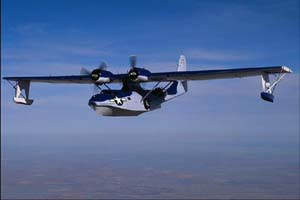Consolidated PBY-6A Catalina
U.S. & Allied Long-Range Patrol Bomber
 |
The Ghost Squadron's PBY-6A. Image source: The Confederate Air Force Ghost Squadron CD-ROM produced by Corel. Photos by Bill Crump. |
In October of 1933, the U.S. Navy placed an order with Consolidated Aircraft for a new flying-boat for patrol service. The resulting XP3Y-1 prototype had a high-mounted single wing, compared to previous Navy flying-boats which were biplanes.
The prototype first flew in March 1935 and sixty were ordered in June, with the new designation PBY-1. The design’s ability to carry a substantial bomb load, justified the change to patrol bomber (PB). Subsequent versions, the PBY-2, PBY-3 and PBY-4, featured more powerful versions of the Pratt & Whitney R-1830 engines.
Delivery of the new patrol planes proceeded rapidly in 1937 and 1938, with 14 squadrons being equipped with PBYs. All of these versions were true flying-boats, with no landing gear, and could only takeoff and land on water. When the aircraft had to be hauled out of the water, they were either lifted out by large cranes or had special wheels and "beaching gear" temporarily attached.
The British also used the PBY and named the design Catalina. Canada also produced the design, calling their version the Canso. A British Catalina located and tracked the German battleship Bismark in May 1941, with U.S. Navy Lt(jg) "Tuck" Smith as copilot.
By the end of 1941, when America entered the war, 16 squadrons were flying PBY-5s, with 1,200 horsepower R-1830-92 engines and capable of carrying four 325 pound depth charges (for use against submarines), two Mark XIII torpedoes or four 500 or 1,000 pound bombs. At the same time, deliveries began of the first amphibious version, the PBY-5A, with retractable tricycle landing gear, allowing operation from either land or water. The final PBY-6A version had a redesigned tail and other improvements.
Able to remain airborne for more than 24 hours in the days before aerial refueling, the PBY served wherever there were oceans in World War II.
Specifications
Normal Crew of Seven to Nine Two Pratt & Whitney R-1830-92 Engines Five .50 caliber Machine Guns Max. Speed 178 mph @ 7,000 feet Initial Climb Rate 650 ft/min |
Length 63' 6" Max. Weight 34,450 lbs Max. Fuel 1,750 gallons Maximum Range 2,535 miles |